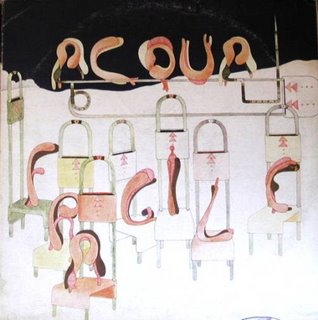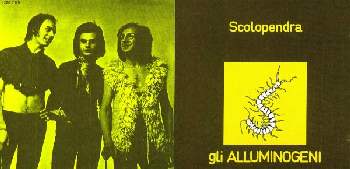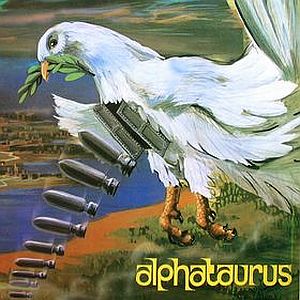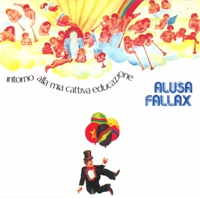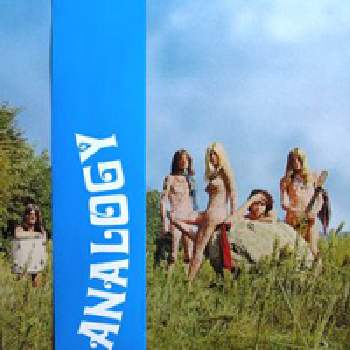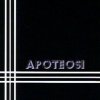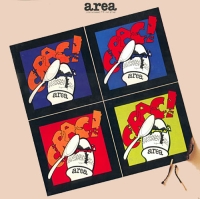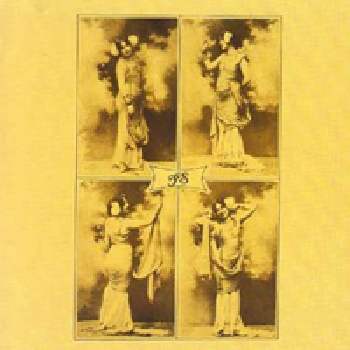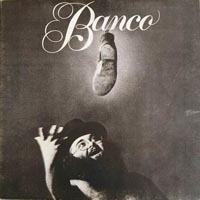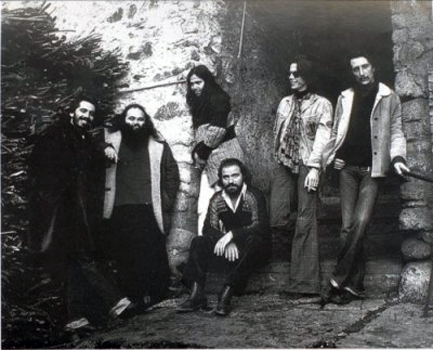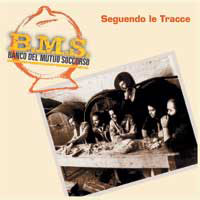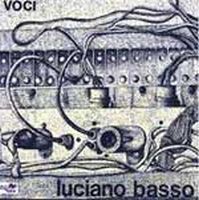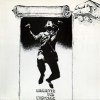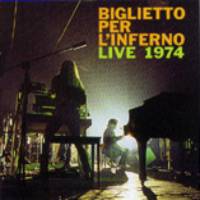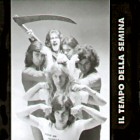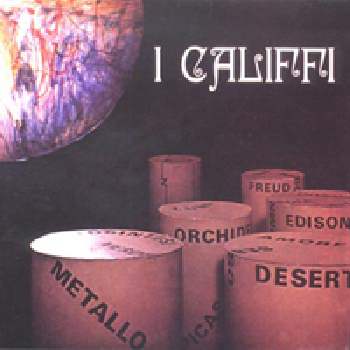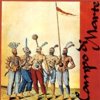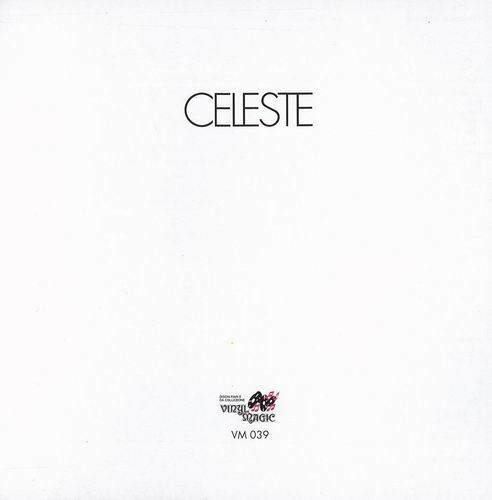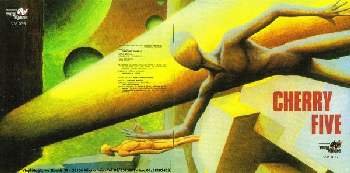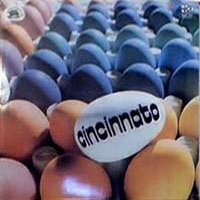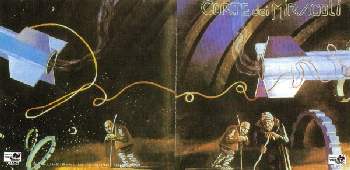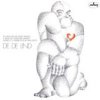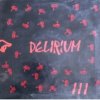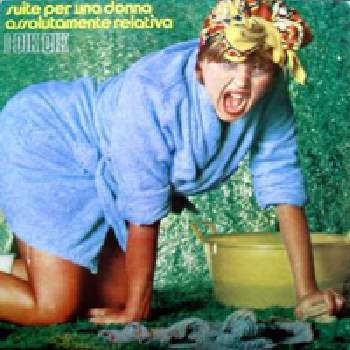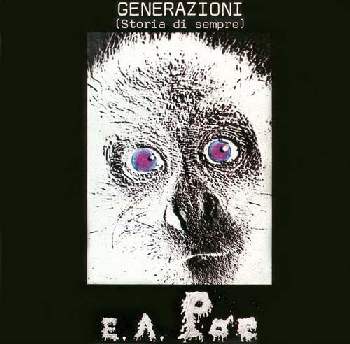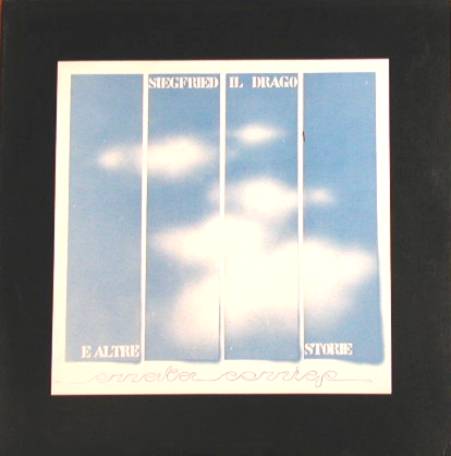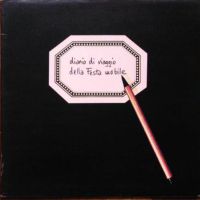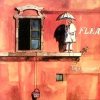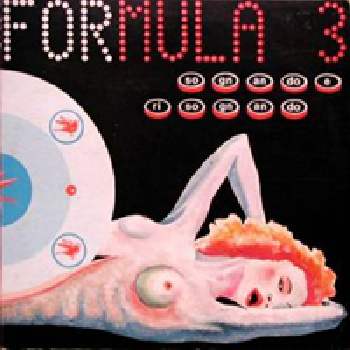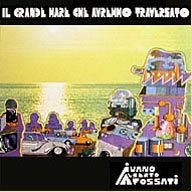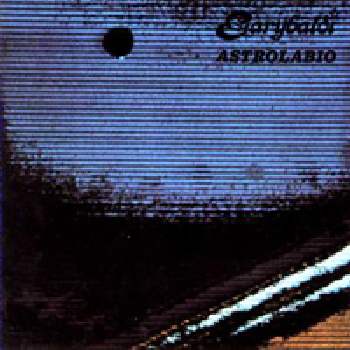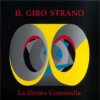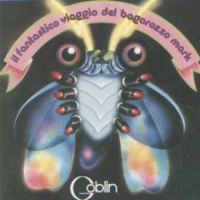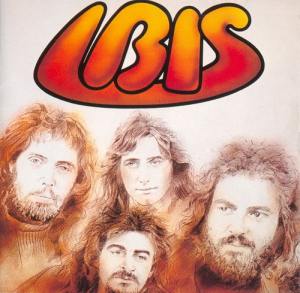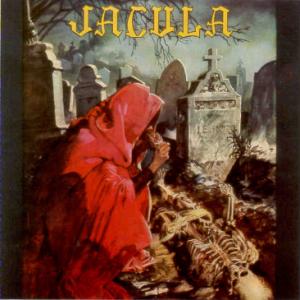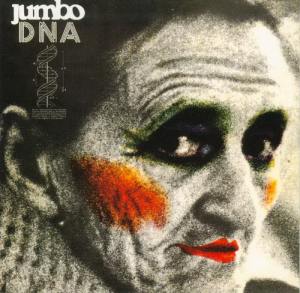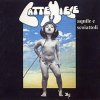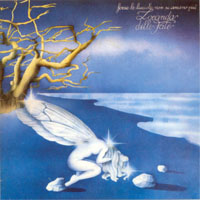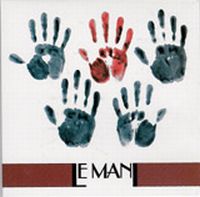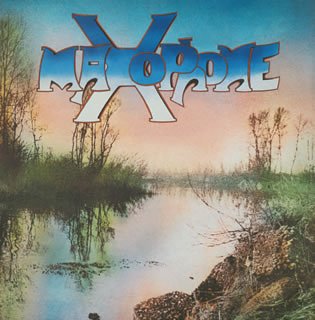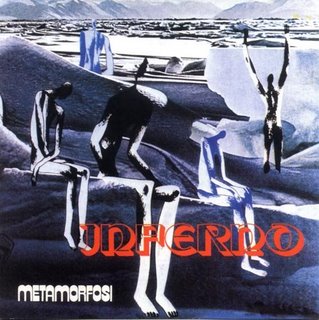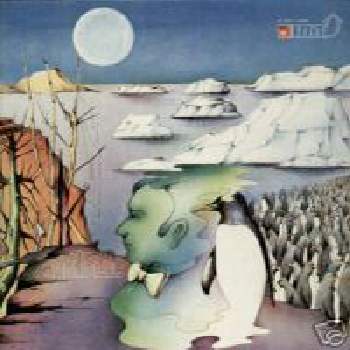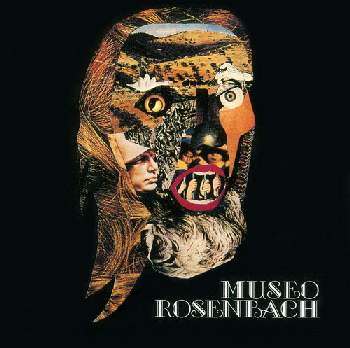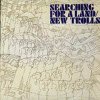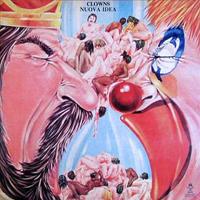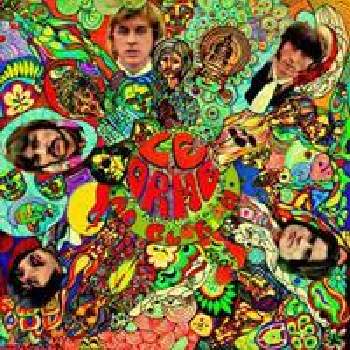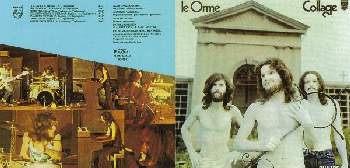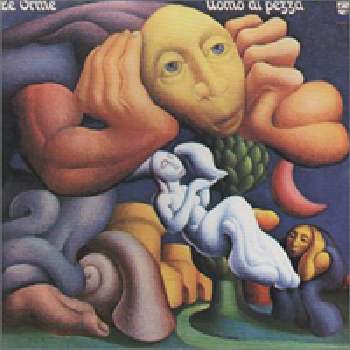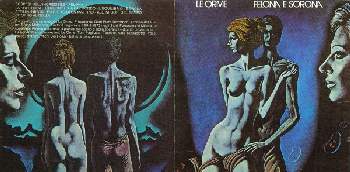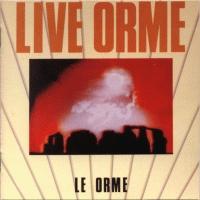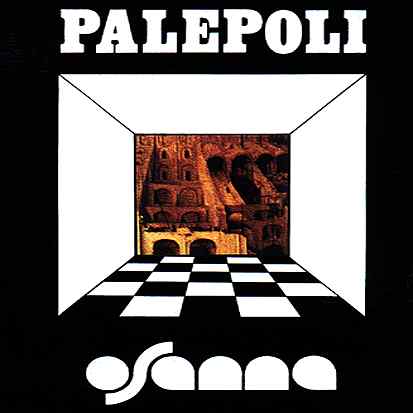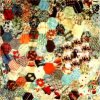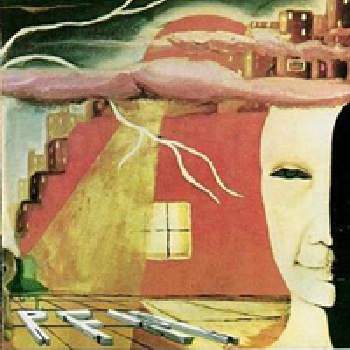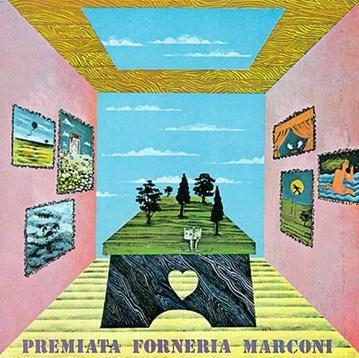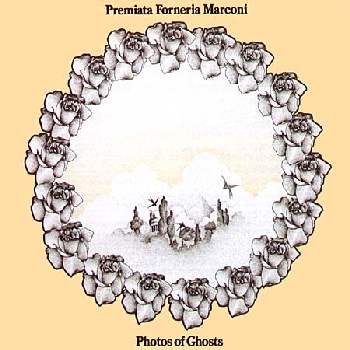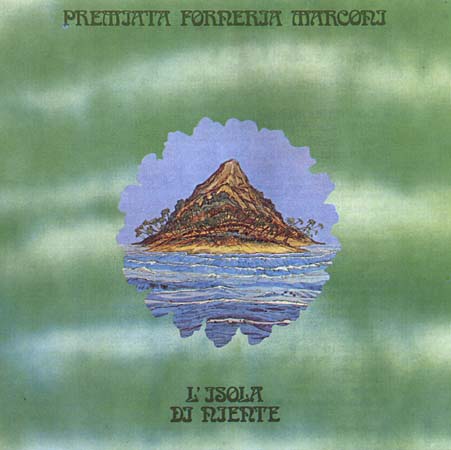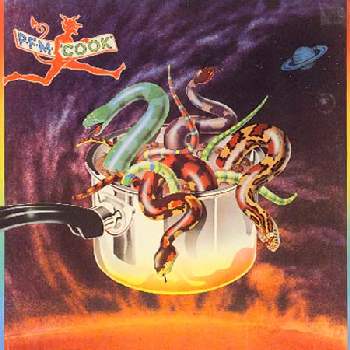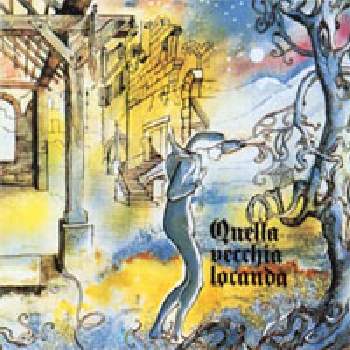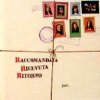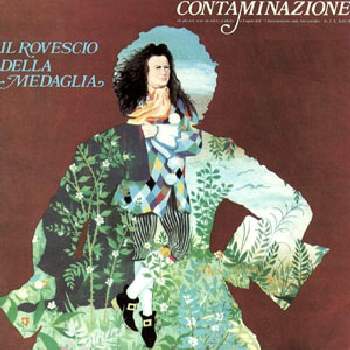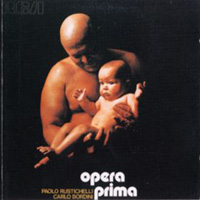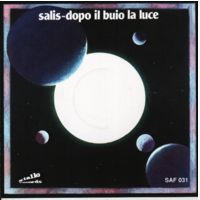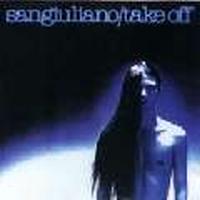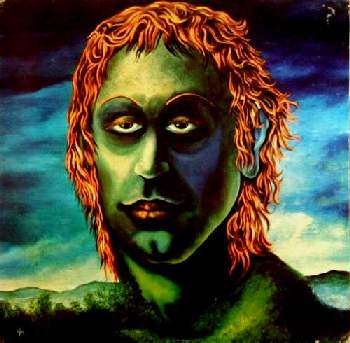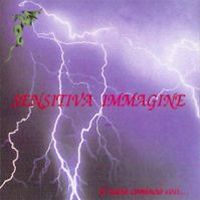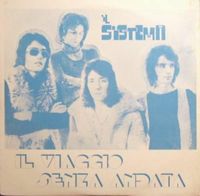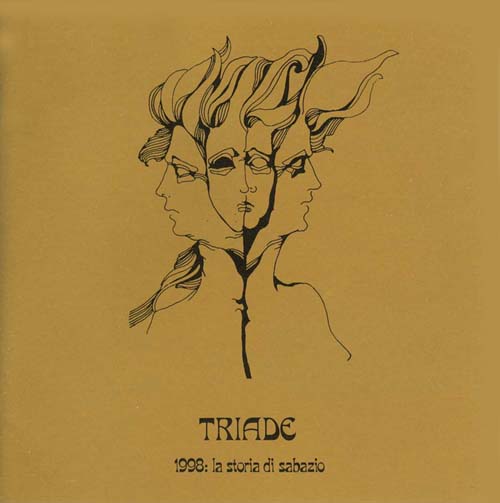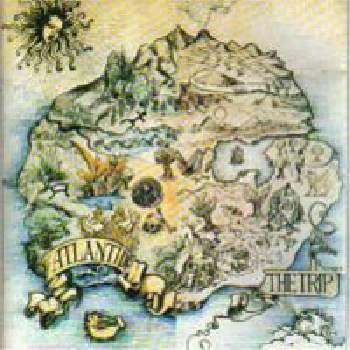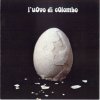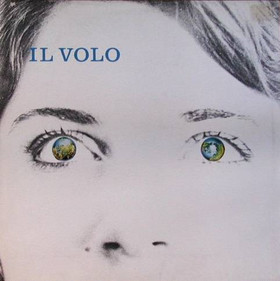ACQUA FRAGILE – Acqua Fragile (1973)
The sound
on their eponymous debut album is pleasant and melodic, reminding me of
Genesis,
Yes
and
Gentle Giant. Their
choice to sing in English is remarkable. Their second effort, entitled
Mass Media Stars (1974), was released in
the USA as well. A year later Acqua Fragile disbanded, singer
Bernardo Lanzetti moved to
PFM and recently he joined
Mangala Vallis, one of the new and
promising Italian prog rock bands.
(GLI) ALLUMINOGENI — Scolopendra (1972)
This is an
often overlooked gem from the Italian seventies prog. The seven compositions on
this debut album are a very dynamic and alternating blend of sixties, blues,
rock and classic featuring excellent work on the Hammond organ, great Italian
vocals and raw electric guitar. The one moment you are carried away by a
bombastic church organ sound, the other moment there is a bluesy electric
guitar or a pleasant and warm sixties atmosphere. Very exciting!
ALPHATAURUS — Alphataurus (1973)
During
their short existence, Alphataurus only released one album, but it is extremely
acclaimed by the Italian prog rock aficionados for two reasons: first, because
of the very captivating music and second, because of the mind-blowing cover
art. Vinyl Magic’s CD reissue with the triple fold out cover is almost worth
the purchase! To start with the latter: the flying white pigeon with an olive
branch in its beak, while throwing bombs is a strong indication for the music:
contrasts, tension and emotion! The album opens with the 13-minutes suite
Peccato D’Orgoglio, an exciting trip
with many changing atmospheres: from dreamy, compelling and bombastic outbursts
to hypnotizing psychedelia and mid-tempo rock, coloured in a fascinating way
with a majestic Hammond organ sound, raw guitar work and passionate Italian
vocals, this is top notch Italian prog rock! Then two shorter tracks: between
dreamy and bombastic with bluesy guitar and splendid interplay between guitar
and piano, topped by excellent vocals in Dopo L’Uragano and between cheerful
and bombastic with honky tonk piano and orchestral keyboards in Croma. The
album ends with two long compositions (around 9 minutes). First, the strongly
build-up La Mente Vola with a romantic undertone, a vibraphone solo and
exciting Emersonian MiniMoog flights, and finally Ombra Muta that delivers
captivating interplay between the guitar and keyboards and great work on the
Hammond organ and MiniMoog. The tension between the slow and bombastic parts is
very compelling and the bluesy vocals match perfectly with the emotional
atmospheres. Enjoy this wonderful blend of rock, blues, symphonic rock and
psychedelia with hints of early
ELP and
Uriah Heep. Highly recommended!
ALUSA FALLAX - Intorno Alla Mia Cattiva
Educazione (1974)
Here’s
another fine one-shot band from the prolific Italian prog rock scene from the
seventies. The sound on their album is melodic and alternating: from mellow,
folky-like pieces with flute, piano, beautiful strings and moving vocals to
accelerations featuring organ and saxophone, but also more fiery parts
delivering electric guitar and protrusive drums or interludes with lush
keyboards.
ANOLOGY – Anology (1972)
Most
members of one-shot-band Anology were Germans who grew up in Italy, just look a
the typical German names like
Schoene and
Nienhaus. Those names sound different from
Mauro Pagani! On
their eponymous debut album
Anology,
often sounds compelling with lots of propulsive guitar work and bombastic
organ. The emotional and powerful vocals emphasize the bluesy undertones in
some songs.
APOTEOSI – Apoteosi (1975)
Another
fine one-shot Italian prog rock band from the seventies. The five tracks on
their eponymous debut album sound melodic and alternating, the female vocals
are wonderful. In the mellow pieces, you hear a lot of strings, piano and flute
often giving the music strong classical overtones. The more up-tempo interludes
contain a strong harmony between the keyboards and guitar. The solo work is
also worth wile listening; the guitar has some psychedelic hints. This album
has many beautiful moments, thanks to the subtle and inventive approach of
these good musicians.
AREA – Crac (1974)
Area made a
lot of records, but their album Crac is generally considered as their best.
Many reviewers name Area ‘the Italian version of
Magma’. You can enjoy an original, very captivating blend of jazz,
rock and ethnic with wonderful mellotron work and varied atmospheres, topped by
the inspired singer
Demitrio Stratos.
The band also hosts
I Califfi guitarist
Paolo Tofani and bass player
Patrick Djivas who later went to
PFM.
ARTI E MESTIERI – Tilt (1974)
This is another acclaimed Italian prog rock band. Their debut album
Tilt is a winner for the jazz rock and
fusion aficionados. You can often enjoy powerful and swinging music evoking
Mahavishnu Orchestra and
Colosseum and featuring awesome
interplay between guitar, violin, saxophone, clarinet and a dynamic
rhythm-section and lots of strong soli. Remarkable is the sound of keyboard
player
Beppe Crovela, who later had
an important role in the nineties Italian prog rock as a producer at Vinyl
Magic. In addition, he is guest musician on many songs with his layers of
mellotron-violin and his inventive work on acoustic and electric piano,
synthesizer and Hammond organ. Sometimes,
Arti
E Mestieri sounds mellow like in the wonderful second part of
Strips: warm Italian vocals, lush
mellotron and twanging acoustic guitar. My highlight is the long composition
Articolazioni: multiple breaks and
accelerations and a pleasant colouring by a wide range of instruments. The CD
reissue contains a bonus track entitled
Scacco Matto
delivering first mellow saxophone and then a mid-tempo piece with a
Fender piano solo and fiery electric guitar play.
(IL) BALLETTO DI BRONZO - Ys (1972)
In my
opinion this is one of the legendary albums that epitomizes the classic Italian
prog rock: on the one hand influenced by the classic prog rock and on the other
hand a very adventurous, typical Italian approach towards progressive rock. You
hear a blend of several styles delivering lots of captivating musical ideas. On
their second album
Ys that appeared
two years after the debut album
Siro 2222,
Il Balletti Di Bronzo takes
us to places in the prog rock galaxy where no one has ever been, scouting the
borders between symphonic rock, psychedelia, jazz and avant-garde. It sounds
very captivating, but you have to be up to the huge variety and the
experimental musical ideas. For example, the long composition
Introduzione alternates between
hypnotizing with expressive, slightly theatrical and high-pitched Italian
vocals, Emersonian sounding Hammond and Moog work and a slow rhythm with
floating mellotron-violin and propulsive drumbeats. The contrast between the
raw electric guitar and the fluent harpsichord runs is exciting! The three
short parts each have its own atmosphere: psychedelic with fiery guitar and
bombastic organ and a final part with tender harpsichord in
Primo Incontro. Heavy and bombastic
electric guitar, Hammond and mellotron with avant-garde elements in
Secondo Incontro and jazz meets
avant-garde, lush Hammond and a delicate duel between jazzy piano and powerful
electric guitar in the experimental
Terzo Incontro.
The long and varied final composition
Epilogo
starts with a swinging rhythm featuring a Hammond organ and
piano duel, topped with expressive Italian vocals. Then a long interlude with a
hypnotizing bass sound and an ominous atmosphere that sounds like ‘a
psychedelia meets avant-garde sound collage’, a bit weird, but also pretty
compelling with adventurous interplay between piano, guitar and keyboards. The
final part is similar to the first part of this epic composition with swinging
rhythms and bombastic work on Hammond and piano. P.S.: the Polydor reissue
contains the short and melodic bonus track
La
Tua Casa Comoda.
That song delivers a pleasant atmosphere with warm vocals,
acoustic rhythm guitar and piano along a vibraphone solo and a nice vintage
keyboard sound. This is Italian prog rock history!
BANCO DEL MUTUO SOCCORSO (aka BANCO) - Banco (1975)
In 1969, members of
Fiori Di Campo and
Experience, at the time two top Italian
bands,
founded
Banco Del Mutuo Soccorso in Rome. The success continued because
the first three albums
Banco Del Mutuo Soccorso
(1972),
Darwin (1972) and
Io Sono Nato Libero (1973) topped
the Italian album charts and the international press invented a nickname for
the Italian prog rock: spaghetti rock. I tried to imagine how exciting it must
have been, to listen to Banco at the time they released their first album! What
a unique blend of several styles, from rock to jazz and from classical to
symphonic rock.
Banco Del Mutuo Soccorso
succeeded in keeping my attention from the very first second until the last,
because of the dynamic, varied and captivating five compositions, loaded with a
very colourful sonor palet by the
Nocenzi
brothers. WE hear awesome interplay, subtle guitar work, an inventive
rhythm-section and very inspired and passionate Italian vocals. My highlights
on this pivotal debut album are the compelling vocals/grand piano duet halfway
R.I.P., the exciting Hammond-drenched
build-up in
Metamorfosi and the
strong shifting moods and lush instrumentation in the epic
Il Giardino Del Mago.
Their second album
Darwin starts in the
vein of the eponymous album with the long composition
L’Evoluzione
with wonderful keyboards and many strong musical
ideas, but then Banco delivers a more adventurous sound with jazzy piano in
Danza Del Grandi Rettili and rather
experimental tracks like
Misere Alla Storia
and
Ed Ora Io Demando.
During the breathtaking song
750.000 Anni
Fa .. L’Amore? we can enjoy the distinctive Banco sound: tender,
classically inspired grand piano and warm vocals with a dramatic, opera-like
undertone. Goose bumps!
The third album
Io Sono Nato Libero is generally considered
as their best effort. To me it sounds as a perfect hybrid of their first two albums:
more adventurous and elaborate than their first and less experimental and
better balanced than their second. Especially the two long compositions
Canto Nomado Per Un Prigioniero Politico
and
Dopo... Niente E Piu Lo Stesso
deliver splendid prog rock with awesome interplay, sensational shifting moods
and spectacular work on the Hammond and MiniMoog. We can also enjoy mellow
twanging acoustic guitar and jazzy Steve Howe inspired runs, topped by
Francesco Di Giacomo’s great vocals.
Banco’s strong classical and folky influences can be enjoyed during
Non Mi Rompete with warm classical
guitar and vocals,
La Citta Sottile
with a beautiful intro on grand piano. The final track
Traccia II
has a strong build-up and pleasant interplay between grand piano and MiniMoog.
In 1975,
Banco was invited to record re-arranged versions of songs from their three
studio albums with an additional new composition entitled
L'Albero Del Pane.
On this fourth studio effort, simply entitled
Banco, the band sounds as never before with new guitarist
Rodolfo Maltese,
who is still a member after almost 35 years).
For
me, this album epitomizes the legendary Italian prog rock sound: hints of the
seventies symphonic rock dinosaurs
ELP,
but presented with those very distinctive classic Italian prog rock elements.
Passionate native vocals, classically inspired compositions with sumptuous
undertones, a pleasant variety of instruments, an eclectic musical approach
from classic and rock to jazz, avant-garde and folk and last but not least,
very crafted, often classically trained musicians. Here is my musical analysis.
1.
Chorale (From Traccia Theme) (2:30):
First, a bit ominous spacey atmosphere, and then lush vintage keyboards by the
obviously classically trained Nocenzi brothers.
2.
L'Albero Del Pane (The Bread Tree) (4:45):
A fluent rhythm in which Banco incorporates elements of rock, classical and
folk, topped with the excellent Italian vocals by Francesco Di Giacomo, one of
my favourite prog rock singers. The duo-keyboard work delivers a wide range of
sounds, from sparkling grand piano and the warm string-ensemble to powerful
Hammond organ runs and fat synthesizer flights, obviously ELP inspired. The
acoustic rhythm-guitar and the adventurous rhythm-section are wonderfully
blended in the lush keyboard sound. The interplay is awesome!
3. Metamorphosis (14:54):
In my opinion the final
composition on side I is one of the highlights in classic Italian prog rock:
classical meets symphonic rock in a very exciting and captivating way. The
first part delivers the distinctive early Banco sound with great interplay, ELP
organ and synthesizer sounds and rock guitar. Then a sumptuous church organ
sound follows forming a bridge to a long part featuring virtuosic solo on grand
piano in the vein of the first ELP album. When the drums and bass join it
culminates to ‘ELP goes avant-garde’ before Banco returns to a 24-carat
symphonic rock atmosphere with sensational Moog synthesizer outbursts. The
music slows down to warm grand piano runs, then spectacular interplay between
fat Moog and sparkling grand piano, soon Hammond and fiery electric guitar join
and again we can enjoy the splendid and exciting Banco interplay. After a
slightly experimental interlude with clarinet evoking the avant-garde side of
King Crimson, Banco delivers a breathtaking build-up and grand finale: first
soaring strings, fragile electric guitar and warm piano, then a compelling
climate with emotional vocals and sparkling grand piano, culminating in
acceleration with bombastic keyboards and a propulsive rhythm-section! What a
power and dynamics and how many goose bumps moments I had during this
mind-blowing final part!
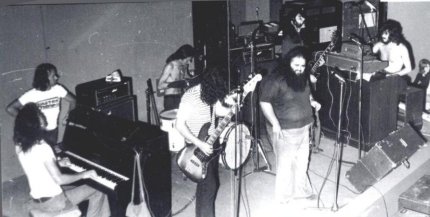
4. Outside (7:42):
In this track, the guitarist is omnipresent
and adds a ‘rock element’ that fits perfectly with the classical sounding
keyboards. In a swinging rhythm, we can enjoy great interplay, warm vocals,
rock-meets-jazz guitar solos, jazzy Fender Rhodes electric piano and
Emerson-oriented Hammond organ. The second part starts mellow with emotional
vocals, beautiful grand piano and warm acoustic guitar, but gradually the
atmosphere turns into a more compelling sound with a pleasant string-ensemble
and strong vocals.
5. Leave Me Alone (5:20):
This composition contains
wonderful duo-classical guitar play and the emotional voice of Francesco,
halfway blended with cheerful acoustic rhythm-guitar and in the end a sparkling
Moog-synthesizer solo, very tastefully arranged.
6. Nothing's The Same (9:58):
Along powerful electric guitar,
the Moog-synthesizer sound, with echoes of Larry Fast, is very important here.
To me, it often sounds if Banco has invited a certain J.S. Bach because of the
very classical way of playing. Again, singer Francesco adds an extra dimension
to the Banco sound, a bit more theatrical than usual but that is part of the
Italian tradition!
7. Traccia II (2:42) :
The final track delivers
outstanding duo-keyboard work, warm grand piano and fat Moog-synthesizer in a
classical atmosphere, gradually turning into a bombastic climax. A perfect end!
Not to be
missed by any Italian prog rock aficionado. This is one of the best classic
Italian prog rock albums ever made!
BANCO - Seguendo Le Tracce (CD 2005)
This
live-album contains never released recordings from 1975, we can enjoy Banco at their
artistic pinnacle. Their captivating and dynamic sound is based upon the
magnificent, omnipresent duo- keyboard play with organ, synthesizers, acoustic
and electric piano, strings by the Nocenzi brothers and the powerful voice from
Francesco Di Giacomo, loaded with pathos. The track list is great featuring
R.I.P. with beautiful interlude
delivering moving piano, vocals and acoustic guitar.
L’Alberto Del Pane has splendid varied keyboards and
La Danza Dei Grandi Rettilli has a
swinging blend of symphonic, blues and jazz. You can enjoy
Passagio, Non Mi Rompete
with pleasant acoustic guitar play and
Dopo … Niente E Piu Lo Stesso with
wonderful sumptuous keyboards and great vocals.
Traccia II has fine acoustic piano play along trumpet and
synthesizer and last but not least, an extended version of about 26 minutes of
Metamorfosi including a long and
virtuosic piano solo, lots of exciting keyboards and shifting moods. If you do
not own records from Banco, this one is a perfect start.
(LUCIANO) BASSO – Voci (1976)
Luciano Basso
is a classically trained and experienced
musician, specialized in grand piano and writing compositions, he has made four
albums (source: book Progressivo Italiano by Barotto & D’Ubaldo):
Voci (1976),
Cogli Il Giorno (1978),
Frammenti Tonali
(1979) and
Luciano Basso
(1980) on the Ariston-label. Later he released five CD’s and nowadays he is a
music teacher in the Italian city of Padua. Listening to his instrumental debut
album Voci, the music reminds me of keyboard oriented seventies prog bands like
Trace,
ELP,
Le Orme and
Triumvirat. They made albums driven by
virtuosic play on the Grand piano as well. From fragile on
Voci and sparkling in
Promenade II and Voci to jazzy in
Promenade II
or wonderful interplay between grand piano and the violin like in
Preludio,
Voci
and the experimental
Echo
with many good ideas, but sometimes it sounds a bit too fragmentarily to me.
Although the grand piano is omnipresent, you can also enjoy a wide range of
vintage keyboards: the mighty Hammond organ and the unsurpassed mellotron,
harpsichord, clavinet, string-ensemble and even a church organ. Some songs
contain sensitive work on the electric guitar. The
Vinyl Magic album features the poorly recorded bonus track
Mignon, s slightly disappointing end to
a beautiful seventies Italian prog album, layered with great work on keyboards.
Especially in the title track, Luciano Basso shows his skills on the keyboards
and in writing compositions!
BIGLIETTO PER L'INFERNO - Biglietto Per
L'Inferno (1974)
Biglietto Per L'Inferno,
a pivotal Italian prog rock
formation, was founded in the early seventies. On their eponymous debut album,
we can enjoy an exciting blend of rock, blues and symphonic rock. The
atmospheres in the six compositions range from dreamy with twanging electric
guitar, flute and mellow organ to catchy rhythms with MiniMoog flights,
swinging piano, bombastic heavy organ waves and harder-edged guitar play. A
strong point in their music is the
Jethro Tull
-like flute play and the omnipresent powerful organ sound that evokes
Rare Bird and
Dave Greenslade like in
Il Nevare.
The magnum opus is the long and alternating
L’Amico
Suicida
that delivers a very tasteful instrumentation (flute, organ,
acoustic and electric guitar) and lots of shifting moods, including a bit
experimental interlude in the second part. I also would like to mention the
strong Italian vocals that contain a warm and emotional undertone. This is one
of the Italian prog rock albums that every prog head must check out!
BIGLIETTO PER L’INFERNO - Live 1974 (CD 2005)
Although
the sound quality of this CD is at the level of an average bootleg, the music
of this Italian prog rock legend is very interesting and often exciting,
because of the wide range of instruments: flute, flugelhorn, Gemorgan, MiniMoog,
Hammond organ, piano, acoustic and electric guitars along drums and bass. As
you would expect the music from Biglietto Per L'Inferno is varied indeed and
contains many shifting moods. The first song consists of a brass section, organ
runs and fiery electric guitar. The other six tracks have echoes from
Jethro Tull including cheerful rhythms,
mellow organ and lots of flute play. The Italian vocals sound inspired but the
compositions are structured as jams. If you like Jethro Tull and the early
Italian prog rock, than this CD is recommended, that is if you have
bootleg-resistant ears!
BIGLIETTO PER L’INFERNO- Il Tempo Della Semina
(CD 1992)
In 1975,
Biglietto Per L’Inferno
intended to
release a second album with 1974 recordings, but unfortunately these recordings
only appeared on a bootleg tape. Finally, the Italian prog rock label Mellow
Records released it as a CD in 1992 entitled
Il Tempo Della Semina. The album opens with the titletrack: a
rather ominous atmosphere, the dark voice from Claudio Canali (also flute)
matches perfectly. This song contains lots of organ, delicate strings and in
the more swinging parts a sound that is similar to
Jethro Tull: powerful and catchy rhythms featuring fiery electric
guitar and the inevitable flute. The first impression is a good one, this track
(about 10 minutes) is alternating and has many captivating moments. Then three
shorter songs follow, each with a completely different atmosphere.
Mente Sola-Mente delivers freaky sounds
and music that evokes
Kraftwerk. In
Vivi Lotta Pensa we hear pleasant
Hammond and Moog-play and some biting electric guitar.
L'Arte
is again in the vein of Jethro Tull. Then a strong composition entitled
Sola Ma Vivo:
the mellow parts contain wonderful keyboards, the more heavy interludes deliver
fiery electric guitar and fine flute work. The final song is their best:
La Canzione Del Padre (almost 10
minutes) is very alternating, from swinging with organ and propulsive with
electric guitar to dreamy with acoustic guitar, rhythm guitar, flute and
soaring keyboards. To me this is a varied prog rock album that will please,
indeed... Jethro Tull fans.
(I) CALIFFI – Fiore Di Metallo (1973)
This is
another interesting one-shot Italian formation with a pretty varied album.
First dynamic rock songs with pleasant keyboard colouring like
Nel Mio Passato with subtle harpsichord
and fluent synthesizer flights,
Varius
with bombastic church organ, organ, synthesizer and a jazzy piano solo and the
compelling
Campane with a Keith
Emerson-like Moog solo. Then more dreamy songs like
Alleluia Gente with wonderful Italian vocals and Moog-solo,
Felicità, Sorriso E Pianto with again
wonderful Italian vocals and
Madre, Domani ...
with twanging guitar, organ and fluent synthesizer runs. Finally
pure rock tracks like
Fiore Finto, Fiore Di Metallo
(propulsive climate),
A Piedi Scalzi
(up-tempo with raw guitar sound) and
Col Vento Nei Capelli with fiery guitar runs. This is not a classic
album, there are so many better albums, but I love the variety, the typical
seventies atmosphere and the Italian vocals!
(IL) CAMPO DI MARTE – Il Campo Di Marte (1973)
Here’s one
of the ‘better lesser known’ Italian prog rock bands, their one-shot in 1973 is
a captivating and dynamic effort, that scouts the borders between rock,
psychedelia, symphonic rock and folk with echoes of other Italian bands like
Il Balletto Di Bronzo,
PFM and
New Trolls.
The seven compositions deliver very varied atmospheres:
mellow with acoustic guitar and flute, rock with heavy guitar work in the vein
of
Jimmy Page and
Ritchie Blackmore, compelling with
psychedelic sounding organ and swinging with swirling organ, fiery electric
guitar and a protrusive rhythm-section. The colouring of the compositions is
very tasteful with a wide range of instruments: classical guitar, flute,
trombone, church-organ and some majestic mellotron-violin waves. An album to
discover.
CELESTE – Principe Di Un Giorno (1976)
Here is a
one-shot-band that made a wonderful album, but don’t expect the usual exciting
keyboard excerptions, complex breaks or unexpected shifting moods. No, the
music on the seven elaborate compositions sound quite mellow and laid-back with
some medieval and jazzy influences and fine work on acoustic guitars, flute,
saxophone and often a majestic mellotron sound that evokes the great days of
early
King Crimson!
CHERRY FIVE-Cherry Five (1974)
Cherry Five
was a one-shot five piece. The line-up included three musicians who later
founded
Goblin, drummer
Carlo Bordini was part of the legendary
duo
Rustichelli & Bordini, that
made the wonderful album
Opera Prima,
and singer
Tony Tartarini had joined
the formation
L’Uovo Di Colombo in
1973 on their eponymous debut album.
The eight
compositions on Cherry Five’s debut album Cherry Five (1974) often deliver
fluent and swinging rhythms with splendid work on the keyboards: from swirling
Hammond solos and lush mellotron-violin waves to jazzy grand piano, sparkling
harpsichord runs and fat MiniMoog synthesizer flights. Due to the powerful
Rickenbacker bass sound, the English vocal harmonies and the fiery
Steve Howe-inspired guitar play, the
seventies
Yes echoes are obviously.
However, in the long and alternating composition
Oliver the omnipresent Hammond organ strongly evokes early
ELP, also because of the Moog
synthesizer work. If you like Yes-oriented bands like
Druid,
England
or
Mirthrandir this overlooked gem will
please you, especially the ‘Tron-maniacs’ will be delighted!
CINCINNATO – Cincinnato (1974)
This is an
Italian four-piece that started to make music in a basement in 1973. They
described their music as art-rock, but after the bass player was replaced,
Cincinnato turned more into a jazz rock
formation. Every time the band went into their rehearsal room, they began with
'a one hour jam' in order to warm up and get inspiration! This became the
foundation of their strong interplay and great instrumental ideas. The four
compositions on the original studio LP from 1974 in general contain slow
rhythms and dreamy atmospheres featuring excellent interplay, powerful guitar
play and tasteful keyboard work: from jazzy piano and beautiful grand piano
play to fluent runs on the ARP-synthesizer. The highlight is the over twenty
minutes long track
L'Ebete. It starts
with warm Italian vocals and piano with a slow rhythm, then lots of flowing
shifting moods featuring exciting duels between piano and guitar, wonderful
work on guitar, from fragile to fiery, and a splendid jazzy piano solo. This CD
release also delivers three bonus tracks: the first two are renditions from two
LP songs (now with vibraphone) and the third is a live recording from 1972, a
raw and mediocre sound quality with lush Hammond and a blistering guitar solo.
This is typical early seventies! If you like jazz rock, this CD will please
you.
CITTA FRONTALE – El Tor (1975)
After legendary formation
Osanna disbanded
in 1974, two members founded the six-piece
Citta
Frontale. Unfortunately,
Citta Frontale
made only made one album entitled
El Tor
consisting of eight compositions, running time at about 45
minutes. The sound is very interesting: a warm and varied blend of folk, jazz
and classical and the use of a wide range of instruments. The album starts with
the instrumental
Alba Di Una Citta,
the folky atmosphere evokes early
Mike Oldfield
featuring twanging acoustic guitar, flute and percussion, a fine
opener. Another instrumental is the jazzy
Mutatione
with sparkling Fender Rhodes electric piano and strong interplay between the
electric guitar and saxophone. The other six tracks sound varied: from dreamy
with warm classical, acoustic guitar and flute to bluesy with mouth harp and
piano to rock with powerful electric guitar and jazz with swinging saxophone.
Often Citta Frontale’s music contains flowing shifting moods and strong solos
and the Italian vocals match perfectly with the very pleasant sound on this
alternating prog rock album.
CORTE DEI MIRACOLI – Same (1976)
Corte Dei Miracoli
is another one-shot-band although Mellow
Records released unknown 1973-1974 recordings in 1992 entitled
Dimensione Onirica. Their music in the
five tracks sound very pleasant, alternating and melodic featuring a lush and
varied keyboard sound by the two keyboard players. They play powerful Hammond,
delicate synthesizer flights, wonderful soaring string-ensemble, especially on
the epic composition
I Due Amanti,
and jazzy Fender Rhodes electric piano. The Italian vocals are strong and the
rhythm-section does well including some inventive percussive ideas. If you like
keyboard driven prog rock with good Italian vocals, I’m sure this album will
please you.
DE DE LIND - Io Non So Da Dove Vengo E Non So
Dove Mai Andrò.. (1973)
The unusual
name of this one-shot-band has been derived from a Sixties Playboy model. Is
the music also exciting and beautiful? Well,
Jethro Tull fans will be pleased with the heavy parts featuring
great flute solos in the vein of
Ian Anderson
and the fiery guitar runs. However,
De De Lind
presents more than prog rock like Jethro Tull. In fact
their sound is pretty varied and contains lots of captivating shifting moods
and breaks. The atmospheres change from dreamy with soaring flute and warm
twanging acoustic guitar to powerful with biting guitar and protrusive drums.
This is a solid Italian prog rock album with interesting guitar work and a good
balance between mellow and heavy parts.
DELIRIUM
– Delirium III : Viaggio Negli Arcipelaghi Del Tempo (1974)
Delirium
was founded in 1970, one year later the band released their debut album
entitled
Dolce Acqua and the hit single
Canto Di Osanna (1971)
resulting in some national popularity. The album is a fine mixture of pop, jazz
and folk with the focus on leader
Ivano Fossati
with his powerful flute play. In the first part of 1972 Delirium
released the singles
Jesahel and
Haum!, a few months later Fossati left
because of army duties. British flute player
Martin Fredrick Grice replaced him. He has a prominent role on the
next album entitled
Lo Scemo E Il Villaggio
(1972) featuring a more jazz oriented sound. In 1974, Delirium
released their most acclaimed album
Delirium III
containing a varied sound: acoustic ballads alternate with instrumental
jazzy tracks, complex prog and even some experimental work. The influences
range from
King Crimson and
Gentle Giant to
Jethro Tull and
Van Der Graaf Generator,
an album to discover.
(I) DIK DIK - Suite Per Una Donna Assolutamente
Relativa (1972)
This is the only progressive album
(I) Dik Dik
(the name is derived from an African gazelle) made but it is an acclaimed one
by prog rock aficionados. The eleven compositions sound melodic and
alternating: from folky to bombastic prog. Although all musicians play very
well, the focus is on the magnificent keyboard play: sparkling piano, swinging
clavinet, sensational synthesizer flights, strong organ floods and majestic
mellotron eruptions. If you like the wonderful sound of the sixties: warm
vocals, acoustic guitars, organ blended with the progressive sound of the early
seventies with
The Moody Blues and
Strawbs, this is an album to check out.
By the way, the album cover is one of the funniest albums covers ever published!
EDGAR ALLAN POE – Generazioni (1974)
Edgar Allan Poe
is a typical seventies Italian prog rock
sounding band, at some moments the band reminds me of early
Metamorfosi: a sixties touch, pleasant
Hammond organ work and a slightly distorted electric guitar sound. We can enjoy
seven simply structured, but tastefully arranged songs with a lot of variety: a
jazzy atmosphere with subtle electric guitar, folky with acoustic rhythm guitar
and mandolin, slow rhythms with compelling Hammond organ, bombastic with
emotional Italian vocals and sumptuous Hammond and Moog. This is a nice effort
with a special flavour due to the organ and the Italian vocals.
ERRATA CORRIGE - Siegfried, Il Drago E Altre
Storie (1976)
This album
is a fine example of the wonderful Italian prog rock from the seventies. To my
surprise the distinctive string-ensemble has been used very frequently, I love
that sound. The six compositions are very melodic and changes from folky and
classical to symphonic, very beautiful. At some moments, the music reminds me
of early
Barclay James Harvest
because of the lush and compelling keyboards, but in general, this is original
prog featuring lots of mellow shifting moods with strong Italian vocals, flute,
piano and cello. This is a rather dreamy album, but certainly not boring! I
prefer this album above their later album
Mappamondo.
FESTA MOBILE – Diario Di Viaggio Della Festa
Mobile (1973)
Another one-shot-band; on their album
Diario Di
Viaggio Della Festa Mobile
the band delivers tasteful and elaborate songs
featuring omnipresent grand piano work evoking early
ELP, along a bit raw and powerful electric guitar play. This album
has been reissued several times on different labels, recently by Sony/BMG in a
jewel case.
FLEA - Topo O Uomini (1972)
This is a
wonderful digi-pack distribution by the prolific Italian label Btf. The
information is in Italian and in English, embellished with nice pictures.
Flea made three LP’s:
Flea On The Honey (1971),
Topi O Uomini (1974) and finally their
most acclaimed effort
Etna (1975).
Topi O Uomini opens with the long title
track, around 20 minutes, which sounds as energetic rock: powerful vocals, raw
guitar with lots of fiery and moving solos, bluesy harmonica and a propulsive
rhythm-section evoking Led Zeppelin. The other three tracks, between four and
seven minutes, deliver more variety, due to the wider range of instruments:
vibraphone, pianoforte, soprano-saxophone and acoustic guitar. We can enjoy a
sound that alternates from heavy to jazzy, very pleasant if you like the
typical rock sound of the seventies and Flea added some fine progressive ideas.
FORMULA 3 - Sognando E Risognando (1972)
Of all four
Formula Tree albums, this is my
favourite one. It contains four compositions divided in several parts. The
music alternates between bombastic symphonic rock and compelling psychedelia
with a wonderful ‘vintage keyboards’ colouring, mainly Hammond organ. You hear
a swirling solo in
Non Mi Ritrovo and
often captivating interplay with powerful guitar, but also string-ensemble, a
wonderful sound in
L’Ultima Foglia: Finale,
Moog-synthesizer, an exciting duel with fiery guitar in
Interludio and piano, a virtuosic solo in
Interludio. A very special track
is the romantic
Storia Di Un Uomo E Di Una Donna,
featuring warm, a bit melancholic vocals. Although this album
sounds a bit fragmented to me at some moments, I love the typical Italian prog rock
sound: a blend of classic prog and adventurous ideas.
(IVANO ALBERTO) FOSSATI - Il Grande Mare Che
Avremmo Traversato (1973)
In the early seventies ex-
Delirium
keyboard and flute player
Ivano Fossati
was considered to be a huge talent. He was 22 when
he released his first solo album in 1973 ; in 1971 he made the LP
Dolce Aqua with Delirium. His solo
effort contains ten compositions each with its own atmosphere: from dreamy to
swinging with a pleasant colouring by the use of instruments like acoustic
guitar, electric guitar, flute traverse, piano and a violin section. Ivano’s
vocals are almost narrative with a bit melancholic undertone, as if he his
putting his unpleasant memories into music. A wonderful album.
GARYBALDI – Astrolabio (1973)
In 1971, the four-piece band
Gleemen
(eponymous debut album in 1970) changed their name into
Garybaldi
with the same line-up featuring the excellent guitar player and singer
‘Bambi’ P.N. Fossati
who sounds obviously inspired by the late sixties guitar heroes
Jimi Hendrix and
Eric Clapton. On their first album
Nuda
(1971) we can enjoy a progressive blend of rock, blues and
symphonic rock with hints of early
Camel.
On their second record
Astrolabio,
the booklet mentions that keyboard player
Lio Marchi
‘gently participated on keyboards’ so in fact the band has been
reduced to a trio with Lio as guest musician. The album contains two long
compositions of about twenty minutes. First
Madre
Di Cose Perdute
that delivers great interplay between guitar and keyboards
with a compelling atmosphere with strong psychedelic undertones. The other
track
Sette was recorded live in the
studio attended by a small audience. It is a long jam session with exciting
Jimi Hendrix and Eric Clapton inspired guitar work including many wah-wah
drenched solos and biting runs. The duels with the omnipresent Hammond organ
sound like Jimi Hendrix meets
Jon Lord. A
wesome! I also enjoyed the long improvisations like a guitar-church organ
duet and a mind-blowing bombastic final part with wah-wah guitar, Hammond
organ, Hohner piano and MiniMoog synthesizer, like Jimi Hendrix meets
PFM. What a unique progressive effort!
(I) GIGANTI – Terra In Boca (1971)
I Giganti
was founded around the mid-sixties. This third
studio-album is their most progressive effort featuring two long compositions,
both over 20 minutes. The music is very alternating and delivers many
captivating moments: heavy compelling keyboard play, subdued acoustic guitar
and emotional vocals, mellow swelling mellotron, especially in the beautiful
intermezzo halfway
Part Two. We hear
virtuosic piano work in the vein of
Keith Emerson,
but more refined, and fiery, propulsive guitar play. Despite the
long running time of the two tracks, it sounds cohesive and pleasant. This very
fine album deserves to be discovered.
(IL) GIRO STRANO – La Divina Commedia
This 1992
CD-release from the 1972-1973 recordings is dedicated to their singer
Mirko Ostinet who sadly died in 1983.
He was one of the most promising and acclaimed Italian voices: powerful,
melodic and emotional. His contribution on this posthumously released album
sounds as the most original of all members because the organ reminds me of
The Nice and
ELP,
the sometimes a bit screamy saxophone evokes
King Crimson and the flute play is in the vein of
Jethro Tull and
Focus. The structure of the five mainly
long compositions sounds simple: lots of organ waves and many soli on
saxophone, guitar and flute. In the tracks
Il
13 Transistor with a
Pictures At An
Exhibition-like atmosphere,
Il Corridoio
with echoes from The Nice and
La Divina Commedia,
a kind of Keith Emerson-tribute, the Hammond-organ is omnipresence.
Il Vecchio Oldsea
starts with guitar work in the vein of
Jimmy Page,
next an acceleration with Jethro Tull-like flute and in the end a
jazz-rock-inspired guitar solo. The vocals are very strong. The composition
Il Pianeta Della Verita delivers
swinging duets between organ and saxophone.
La
Devina Commedia is good album from the Mellow Records label.
GOBLIN - Il Fantastico Viaggio Del Bagarozzo
Mark (1978)
I’ve never been a fan of
Goblin, but I
appreciate this album very much because of its pure symphonic rock sound. The
album contains for the first time vocals. The eight compositions feature strong
and beautiful interplay between a fiery and flowing electric guitar and
sumptuous keyboards with lots of organ and some flashy synthesizers with echoes
from
Keith Emerson. Some songs are
different and even contain rock and roll elements. Many prog heads consider
this album as the best Goblin ever produced.
IBIS – Ibis (1975)
This eponymous album from Italian band
Ibis
is not their debut, as you would expect from the title, but their third after
the records
Canti d'Innozenza, Canti d'Esperienza
(1973) and
Sun Supreme
(1974). The prime mover is singer and guitarist
Nico Di Palo, known as a member of the legendary Italian formation
The New Trolls. The music on Ibis is
varied: the two long tracks
Narratio and
Ritrovarci deliver sumptuous
keyboards a bit similar to my favourite Hungarian band
Omega and fiery guitar duels. The song
Passa Il Tempo
contains wonderful acoustic guitar and
Keep On Movin’
features straight rock and roll! My highlight on this album is
Strada,
a beautiful blend of electric piano, sensitive electric guitar, flute and a
swinging rhythm-section. To me this sounds as a pleasant and varied album, no
more, no less.
JACULA – Tardo Pede In Magiam Versus (1972)
Jacula was a musical project by
Anthony Bartocetti
(guitars, bass and vocals) and
Fiamma Dello Spirito
(lead vocals, violin and flute). In 1969, Jacula released their first album
In Cauda Semper Stat Venenum, in 2001
reissued on CD by Black Widow Records.
Tardo Pede
In Magiam Versus (1972) was
their second effort, in 1992 reissued by Mellow Records and in 2007 by Black
Widow records. In 1974, Jacula changed their name into
Antonius Rex. On
Tardo Pede In Magiam Versus
the line-up features Anthony and Fiamma playing together with
Charles Tiring (organ,
harpsichord, Moog and vocals) and
Franz Partheny
as a ‘medium’, the five compositions came from spiritual séances.
Most of the music has been built around a majestic, often bombastic church
organ sound, especially in the first composition
U.F.D.E.M, with tender harpsichord and strong, passionate female
vocals and in the final track
In Old Castle.
In the song
Praesenta Domini,
the vocals sound spooky, evoking the necrophilia front cover art, and in
Long Black Magic Night
the dreamy atmosphere
is coloured by harpsichord and flute. Unique, very fascinating progressive
rock!
JUMBO – DNA (1972)
Awful cover, awesome music! The Italian band
Jumbo
made three albums in the seventies; this is their second one. The focus is on
the raw and expressive voice of singer
Alvaro Fella.
He colours Jumbo’s music, plays acoustic guitar and is the main
composer. This album starts with the twenty minutes composition
Suite Per Il Sign. The epic contains
many shifting moods, breaks and soli and the use of a wide range of
instruments: piano, flute, mouth organ, heavy floods of organ and heavy
electric guitar. The track
Miss Rand
starts with bombastic organ and next a swinging rhythm with catchy piano play.
E. Butto Sentirsi Vecchi sounds dreamy
featuring twanging acoustic guitar and cheerful flute work. The final
composition
Hai Visto, has a rather
jazzy atmosphere and lots of soli on flute and organ.
DNA
is not a very elaborate or complex album, it simply sounds
pleasant with lots of strong soli.
LATTE E MIELE - Aquile E Scoiattoli (1976)
Latte E Miele
is an acclaimed Italian band from the
seventies. On their first two albums, we can enjoy cascades of shifting moods,
breaks, accelerations and the atmospheres change from classical overtones to
ELP-like keyboard work or even heavy
metal. This third album is the most accessible one. I trace echoes from the
early Genesis especially as far as the keyboards are concerned. The long and
impressive
Pavane (almost 25 minutes)
reminds me of
The Enid,
Sky and
Craft.
If you prefer more complex and adventurous prog, I prefer
the first two albums to start with, but if you like more melodic prog, this is
one to discover.
LOCANDA DELLE FATE - Forse Le Lucciole Non Si
Amano Più (1977)
On this one-shot effort the septet
Locanda Della Fate
delivers wonderful symphonic
rock in the seven melodic and accessible compositions with an omnipresent, very
beautiful grand piano sound, pleasant synthesizer work, moving electric guitar
and some inspired flute play with echoes of seventies Genesis. The title track
has passionate Italian vocals, wonderful interplay between sparkling grand
piano and
Steve Hackett-like guitar
play and many interesting shifting moods. The final composition
Vendesi Saggezza has a strong build-up
with wonderful vocals and grand piano, howling electric guitar and exciting
breaks with clavinet and synthesizers. Apart from the excellent dynamic and
varied sound this highly acclaimed album sounds a bit too laidback for me. Of
course, it’s all a matter of taste, because I know many prog heads who
disagree!
(LE) MANI – Le Mani (CD 2006)
This Italian band was rooted in the early seventies, halfway that era
Le Mani recorded five studio tracks,
but unfortunately the record companies
ignored them and Le Mani disbanded without making an album. Thanks to the
support of Italian prog rock label Vinyl Magic, the music can be heard on this
mini-CD, running time about 19 minutes, released in 2006.
1.
Tarantella: A fluent song featuring fast
organ runs and sparkling flute play. It sounds typical seventies Italian but
the music also reminds me of Hungarian prog rock legend
Solaris.
2.
Il Palazzo: Again, a fluent rhythm with
organ and saxophone, halfway the music gets dreamier with the wonderful sound
of the string-ensemble.
3.
Canto: This track delivers a cheerful
atmosphere with acoustic guitar, pleasant Italian vocals and fine flute work.
This is the typical Italian seventies prog rock sound!
4.
Mani: Solo piece on the grand piano,
sounding beautifully.
5.
La Casa Del Vento: The final song
contains warm vocals and sensitive piano play, a pleasant goodbye to Le Mani.
What a pity
that Le Mani only made five studio tracks. They deserved an entire studio
album!
MAXOPHONE – Maxophone (1973)
Maxophone
was a six-piece that existed between 1973 and
1977. They released only an eponymous album in 1973. The melodic sound has
strong jazz-rock undertones with lots of woodwind and brass instruments: flute,
saxophone, clarinet, French horn and trumpet. The atmospheres vary from dreamy
with flute and acoustic guitar to bombastic with an orchestra or heavy with
powerful guitar work. The vocals evoke the distinctive voice of Peter Gabriel.
In 2005, the Italian labels Btf./Vinyl Magic collaborated in order to release
the CD/DVD box set
From Cocoon To Butterfly
that contains previously unreleased material, interviews and
TV-recordings, recommended to the fans!
METAMORFOSI – Inferno (1973)
Metamorfosi
was founded in the second half of the sixties.
In 1972, the band released their eponymous debut album. The simply structured
seven compositions sound very melodic with a pleasant sixties touch. The focus
is on the Hammond organ and the very distinctive vocals: warm and inspired with
a strong pathetical undertone. Remarkably are the harder-edged guitar solos
together with the nice synthesizer flights in
Hiroshima. One year later, Metamorfosi made a second LP entitled
Inferno sounding superior to their first
effort. The spirit of Keith Emerson is omnipresent in all twelve tracks. These
tracks are varied and often compelling, but at some moments a bit fragmented.
We hear an exciting vintage keyboard sound: the impressive sound of a
church-organ, fat MiniMoog flights, delicate harpsichord runs, sparkling grand
piano and swirling Hammond organ, topped by great Italian vocals. This is one
of the classic Italian prog rock albums!
MURPLE – Io Sono Murple (1974)
The quartet
Murple
released only one album in
1974 on a German label and the reissue on CD was on a German label (Akarma) as
well. Murple plays in the 24-carat symphonic rock tradition with a lush organ
sound and flowing electric guitar, reminding me of nineties Italian prog rock
band
Nuova Era. In 2007, three
members of the original line-up reunited and made a new album in 2008 entitled
Quadri Di Un'Esposizione on the Btf-label.
MUSEO ROSENBACH – Zarathustra (1973)
In the early nineties, I started to search for the Italian prog rock from the
seventies. The mail order catalogues from the prog rock labels Laser’s Edge en
Syn-Phonic became my most important sources. I still enjoy the warm and
enthusiastic descriptions of Ken Golden and Greg Walker about bands like
Il Balletto Di Bronzo,
Cherry Five,
I Dik Dik and
Edgar Allan Poe.
One highly acclaimed group was
Museo Rosenbach
with their album Zarathustra, about Nietzsche’s super human, from
1973. This album had such euphoric reviews that I decided to order it. Well,
very soon I was mesmerized by the splendid title track, a twenty-minute killer
composition with echoes from
Genesis and
King Crimson. The foundation of
this wonderful and moving song is a beautiful theme, like
Firth Of Fifth
by Genesis, that returns in different atmospheres:
from dreamy to heavy and bombastic and with different colouring of the
instruments. The interplay between the electric guitar, keyboards, rhythm-
section and the strong and expressive Italian vocals is very captivating. It
all creates a constant tension, topped by majestic eruptions of the mellotron.
These moments give the title track the same compelling impact as it does on the
early albums of King Crimson. Goose bumps all over! The other three shorter
tracks sound flowing and powerful with a lot of Hammond organ and guitar play
with echoes from
Steve Hackett. For
me this album is one of the absolute highlights of the adventurous and varied Italian
prog rock scene in the seventies. A must-have!
NEW TROLLS – Searching For A land (1972)
This Italian prog rock legend has made many albums, my favourite is this 2-LP
(re-released on 1-CD). What an exciting music! All tracks strongly alternate:
David Bowie-like vocals in
Searching, warm twanging acoustic guitar
in
Giga, splendid mellotron waves in
In St. Peter's day, beautiful classical
inspired piano play in
Once That I Prayed
and raw and heavy rock with hints from
Led Zeppelin
and
Deep Purple in
To Edith and
Lying Here with
Ian Gillan-like
vocals. Only few albums sound so varied and captivating. This one deserves more
attention!
NUOVA IDEA – Clowns (1973)
This is
Nuova Idea’s
final effort and to me it
is their best one. The line-up has been changed, the music delivers a raw organ
and guitar sound that only has a few mellow moments. The vocals are powerful,
but sometimes a bit too screamy. The title track is the most captivating and
alternating composition. Due to some experimental ideas like the use of brass
instruments Nuova Idea is not always a band with an accessible approach.
Nonetheless, this is one of the better releases from the Italian prog rock
label Mellow Records.
(LE) ORME – Ad Gloriam (1969)
My favourite classic Italian prog rock band
Le Orme
was founded in 1967. Especially their albums
Felona E Sorona and
Collage
manage
to delight me with every spin. This album features music from their very early
period in the late sixties and you may consider this album as a starting point
of my article about forty years Italian prog rock. The cover is typical ‘flower
power’ art. I like it very much because of its creativity and many colours. The
eleven compositions are simply structured, but tastefully arranged and contain
a varied instrumentation: flute, acoustic and electric guitar, keyboards
(piano, harpsichord and organ) together with warm vocals. Some tracks deliver a
short, psychedelic inspired intro like
I Miei Sogni
and
Fumo with echoes from
Syd Barrett era
Pink Floyd. Other songs have hints from
The Moody Blues,
The Beatles
and
Rare Bird.
To me, this CD sounds as a pleasant progressive blend of
beat, flower power and rock.
(LE) ORME – Collage (1971)
After two
psychedelic/sixties inspired albums, this third record is a true prog rock gem.
The seven compositions feature great Hammond organ play (
Keith Emerson, early
Jane and
Ramses),
very distinctive and
warm vocals with a melancholic undertone, some acoustic guitar and a dynamic
rhythm-section. A very good element in the music from Le Orme is the tension
between the mellow and bombastic atmospheres. And Le Orme delivers a lot of
musical surprises like a kind of
Blackmore/Gillan-Page/Plant duel from the bass and Hammond organ in
Cemiento Armato,
wonderful Hammond organ work from psychedelic to church organ in
Evasione Totale and exciting interplay
between organ and drums in
Era Inverno.
This album is not as refined as
Felona E Sorona,
Uomo Di Pezza or
Contapuntti, but it is very worth listening.
(LE) ORME – Uomo Di Pezza (1972)
When
Le Orme
started touring to promote this album, one of their guests was
Peter Hammill.
Both this album and the single
Gioco Di Bimba
turned into a very successful effort. Le Orme were hot in
Italy in those days!
1. Una Dolcezza Nuova (5:28): After a church organ-like intro,
the music alternates between propulsive and bombastic featuring a dynamic
rhythm-section, great organ runs with strong echoes from
ELP
and dreamy with sensitive acoustic piano. The Italian vocals
sound very warm with a melancholic undertone. Excellent!
2. Gioco Di Bimba (2:54): This was the hit single featuring
a mellow atmosphere with acoustic rhythm guitar, synthesizer flights and warm
vocals along a surprising break with mandolin and clavinet.
3. La Porta Chiusa (7:28): This track has captivating atmospheres
changing from romantic to bombastic with great Hammond and Moog play. The final
part contains wonderful interplay between Hammond and grand piano and a short
but sensational, dynamic piece in the vein of ELP.
4. Breve Imagine (2:42): wonderful mellotron-violin eruptions and warm vocals and bass. Goose bumps!
5. Figure Di Cartone (3:48): This track delivers fat Moog flights with obvious hints of
Keith Emerson’s
work on the Moog synthesizer in
Lucky Man.
6. Aspettando L’Alba (4:43): A romantic atmosphere with warm
vocals and acoustic rhythm-guitar, in the end delivering some mellotron-flutes.
7. Alienazione (4:43): This is Le Orme in their most
bombastic tribute to ELP with dynamic drums and spectacular keyboard play. This
sounds so exciting! This is another masterpiece from the Italian seventies
prog!
(LE) ORME - Felona e Sorona (1973)
During the seventies
Le Orme
turned from a very
ELP
inspired band into a more
refined prog rock formation with a distinctive sound. The concept-album
Felona E Sorona is their acclaimed
‘magnum opus’ featuring nine alternating and elaborated compositions with lush
and varied keyboards, wonderful changing atmospheres and a strong, dynamic
rhythm-section. The final part is one of the most compelling ‘grand finales’ I’ve
ever heard: slow and fat Moog runs, repetitive organ chords, a powerful
drumbeat, a propulsive rhythm-section, culminating in a very moving and
sumptuous atmosphere featuring dazzling Moog-flights and great string-sounds.
What a mind-blowing experience! This is the amazing classic Italian prog rock,
one of my all time favourites.
(LE) ORME - Live Orme (2-CD 1986)
If I look
at the Italian section of my prog rock collection, it seems to be a battle
between
PFM,
Banco and
Le Orme, but
the latter is my favourite band. I tend to choose seventies Le Orme because of
their splendid compositorial qualities, huge musical skills, great dynamics and
perfect blend of technical and emotional elements. In the mid-nineties, I
noticed this live-CD, as a good bootleg, in the catalogue of Musea, the
well-known French prog rock label and mail-order service, and decided to buy
it. These live recordings were never released on vinyl, but fortunately
released as a double album in 1986 by Japanese labels Nexus and in 1993 by King
Record. The line-up on
Live Orme was:
Aldo Tagliapietra (vocals, bass and
guitars),
Antonio Pagliuca (keyboards),
Michi Dei Rossi (drums and percussion) and
Germano Serafin (guitar). Eventually
Live Orme turned out to be
one of my most expensive orders (almost US $ 90). It took many months before I
received the album, but then it was time to let me carry away by this great
Italian prog rock sound. I can tell you that
Live Orme is one of my most precious Italian prog rock documents
because the 2-CD contains great renditions of all the ‘classics’:
Contrappunti,
Maggio,
Gioco Di Bimba,
Era Inverno,
Truck Of Fire,
Cementi Armato,
Collage and the surprising, but
unfortunately short covers from
Led Zeppelin’s
Whole Lotta Love and
Jethro Tull’s
Aqualung. I’m delighted about the wonderful changing atmospheres,
from warm and melancholic featuring the great, very distinctive Italians vocals
and pleasant acoustic guitar, to compelling and bombastic in the vein of
The Nice and
ELP.
OSANNA – Palepoli (1973)
Between 1971 and 1974, the interesting five piece formation
Osanna
released four studio albums, in general their third entitled
Palepoli is considered as the most
acclaimed one. The album contains three songs, two epic compositions between 18
and 22 minutes and a very short track below two minutes. The sound on the two
long compositions is very varied, it ranges from dreamy with warm vocals, flute
and twanging acoustic guitar to heavy rock with harder-edged R&R guitar
with some wah-wah and powerful
Jethro Tull
inspired flute. In between, we can enjoy lots of lush mellotron-violin
waves, accompanied by instruments ranging from mellow flute and soaring Hammond
organ to fiery electric guitar and screamy saxophone. Especially the final part
of
Animale Senza Respiro delivers
majestic mellotron work. If you have no problem with the somewhat dated sound,
this is an album to check out.
(IL) PAESE DEI BALOCHI – Same (1972)
This is one
of the acclaimed typical seventies Italian prog rock albums with a varied sound
in the ten compositions, ranging from classical (cello, Vivaldi-like violins
and Bach-like church organ) and folky (acoustic guitars) to symphonic rock (
ELP-inspired with lots of Hammond
organ) and psychedelia. The reissue of Italian label Mellow Records contains
two bonus tracks that sound rather romantic.
Fantasia E Poesia has a
Procol Harum
sounding Hammond organ and
Amore Per Gico
is close to pop with sensitive guitar runs. However, both tracks
do not really represent the interesting and adventurous sound of the original
album.
PANNA FREDDA - Uno (1971)
Panna Freda
was an Italian band that made only one album entitled
Uno. You don’t need an
Italian dictionary to understand that this means 'one', but to my surprise
Panna Fredda showcases two sides on their album! The first and final part
features swelling and moving organ play and raw guitar work that sounds a bit
like early
Eloy. It all sounds very
sumptuous, mainly due to the heavy Hammond organ chords. Halfway this album,
however, Panna Fredda changes their sound to very mellow, featuring acoustic
guitar, sensitive vocals and medieval-like keyboards. Wonderful, a unique
album, often overlooked.
PREMIATA FORNERIA MARCONI (aka PFM) -
Storia Di Un
Minuto (1972)
The debut album
Storia Di Un Minuto of
PFM has strong echoes from early
King Crimson, especially the ‘feminine’
side. In general, the seven compositions contain beautiful and mellow
atmospheres featuring lots of acoustic guitar, soaring keyboards and warm
vocals, interfered by bombastic mellotron drenched eruptions and fat
synthesizers. At other times, you can hear shifting moods with fiery electric
guitar and swinging rhythms. The highlight is the track
Dove-Quando Part Two
delivering a great variety and a wide range of
instruments: flute, piano, violin, organ and electric guitar. The album lasts
only 34 minutes, but I prefer quality above quantity.
PREMIATA FORNERIA MARCONI - Per Un Amico (1972)
On the second album
Per Un Amico
PFM has even matured their sound:
wonderful symphonic rock featuring acoustic instruments like the piano, violin,
acoustic guitar and flute together with electronic instruments like the
mellotron and the MiniMoog synthesizer. The atmospheres change more frequently
including up-tempo rhythms with electric guitar or a surprising church-organ
intermezzo. The songs are very melodic and harmonic and the vocals are powerful
and expressive. Another classic!
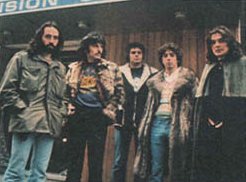
PREMIATA FORNERIA MARCONI - Photos Of Ghosts (1973)
On their third album we read that
Pete Sinfield
from
King Crimson produced this
record and also delivered the lyrics, not really a coincidence if you listen to
the main influence for
PFM! All
songs sound strong and are tastefully elaborated. The music sounds as a
pleasant mix of folk, classical and symphonic. The violin play is excellent! A great
song is the long
Il Barchetto
containing lots of majestic mellotron and sparkling classical piano work.
Unfortunately, the vocals are not in the native language.
PREMIATA FORNERIA MARCONI - L'Isola Di Niente (1974)
On the fourth album
L’Isola Di Niente
(English version
The World Became The World)
I noticed again an obvious influence from early
King Crimson, and again the ‘feminine’ side in the vein of tracks
like
Epitaph and
In The Court Of The Crimson King featuring bombastic mellotron and
Moogs together with folky acoustic instruments. Another influence is
Yes: powerful and propulsive guitars
and keyboards with echoes from
Steve Howe
and
Rick Wakeman. Some
parts even contain jazz-rock-like music, so there are a lot of varied styles on
this album. Although sometimes my attention slips away. This album has many
strong songs, especially the compelling mellotron-drenched title track. Goose
bumps!
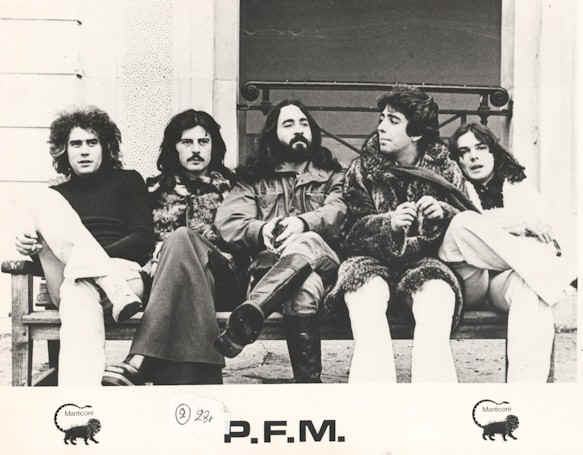
PREMIATA FORNERIA MARCONI –
Live In USA aka Cook (1974)
This album
is a registration of a concert from 1974 while touring in the USA. To me it is
a perfect compilation of their best work and shows the band at its pinnacle.
Four Holes In The Ground has a
propulsive rhythm and a catchy melody, delivering fat MiniMoog synthesizer
runs, some fiery electric guitar and impressive Hammond organ and majestic
mellotron waves in the mellow interludes. The English vocals sound warm and the
interplay between the skilled musicians is great. Next is
Dove ... Quando
with a classical/jazzy intro on the Fender Rhodes
electric piano, turning into a duet with sparkling piano and beautiful Italian
vocals.
Just Look Away has a splendid
acoustic guitar intro followed by twanging acoustic guitar, soft MiniMoog
flights and warm English vocals. The build-up with Hammond and flute is great
with a closing section with tremolo guitar. The ‘crowd-pleaser’
Celebration is a cheerful and catchy
composition, delivering spectacular MiniMoog runs and swirling interplay. The
grand finale includes the moving final part of
The World Became The World. Enjoy the mellotron floods! PFM is ay
their best in
Mr. Nine Till Five with
the distinctive interplay between flute, Moog and violin. The final song
Alta Loma Five Till Nine includes a long
and bluesy guitar solo with a strong build-up, supported by mellotron-violin,
featuring howling and biting licks: superb! The second part has a moving violin
soli, culminating in a version of Rossini’s piece
William Tell Overture
with virtuosic play on the Moog-synthesizer and violin. This is without doubt
my favourite PFM album!
QUELLA VECCHIA LOCANDA - Quella Vecchia Locanda (1972)
This is one
of the most acclaimed albums of the Italian prog rock, a unique progressive
blend of folk, classical and rock. The band consists of six musicians playing a
wide range of instruments: an array of vintage keyboards including soaring
mellotron-violin and MiniMoog, saxophone, twelve-string, acoustic and electric
guitar, flute.
QVL’s eponymous debut
album contains eight beautiful, original and dynamic compositions. The one
moment the atmosphere is dreamy with warm vocals and twanging acoustic guitar,
classical flute and violin; at other moments, we hear up-tempo rock with fiery
electric guitar, a catchy beat with swinging piano or a part with a
Jethro Tull-like flute sound or a grand
piano solo. The strong Italian vocals add an extra dimension to the very
pleasant atmosphere on this album. Simply wonderful!
RACCOMANDATA CON RICEVUTA DI RITORNO (aka RRR)
– Per .. Un Mondo Di Cristallo (1972)
If you want
to discover unique, not very accessible, but alternating prog rock in the vein
of
King Crimson and
Gentle Giant. You can also enjoy a wide
range of instruments: from acoustic guitar and flute to saxophone and even a
church organ! Never a dull moment! What a varied, typical adventurous Italian
progressive rock! Check out this one!
(IL) ROVESCIO DELLA MEDAGLIA (aka RDM) –
Contaminazione (1973)
The third RDM-album is their best. It features lots of
Keith Emerson
inspired Hammond organ play. Together with the
propulsive and dynamic rhythm-section, it evokes also
Trace and
Ekseption, featuring the late Dutch pride
Rick van der Linden.
The instrumentation varies, including violin, harpsichord,
heavy guitar, a violin-section, piano, classical guitar and church organ. At
some moments, the music sounds a bit freaky or experimental, but in general
this is wonderful melodic seventies based prog rock. The Italian vocals are
beautiful and warm. By the way, this album is a kind of tribute to Johan
Sebastian Bach, especially the composition
Toccata
In D-Fuga.
RUSTICHELLI & BORDINI – Opera Prima (1973)
Rustichelli & Bordini
made this wonderful album.
Unfortunately, it turned out to be their swan song. The cover picture is very
original: a nude and bald heavy weight man who tenderly holds a baby in his arms.
To me this is a metaphor for the music, ranging from warm to bombastic. Drummer
Carlo Bordini later joined
Cherry Five and
Goblin, but before the first album was released, he was sacked.
1. Nativita: The album starts with a swinging rhythm
featuring inventive drums, a warm bass sound and lush keyboards with Hammond
organ, mellotron and piano. The atmospheres alternate from mellow with soaring
mellotron-violin and classical inspired piano to swinging with lots of Hammond.
The interplay between the keyboards is wonderful and the rhythm-section sounds
great.
2. Icaro: This is a mid-tempo song with splendid play
on the Hammond, featuring a church organ like sound, a jazzy piano part and
strong vocals with an emotional undertone.
3. Dolce Sorella: Again, we can enjoy a wonderful lush keyboard
sound delivering classical orchestrations, synthesizers and sparkling piano.
The vocals sound melancholic and fit perfect to the bombastic atmosphere.
4. Un Cana: The first part contains beautiful classical
piano, next a full symphonic sound, emphasized by synthesizers, mellotron,
piano and emotional vocals.
5. E Svegliarsi In Un Giorno: This track features many Hammond
organ floods and strong vocals, it carries you away to prog heaven !
6. Cammellandia: First, you hear bombastic organ, fat
synthesizers flights, then an ominous sounding mellotron-violin and dynamic
drums. The atmosphere’s changes into bombastic with propulsive drums and a lush
Hammond and mellotron sound, gradually the mellotron becomes more and more
omnipresent and is blended with the Hammond and drums in an exciting way! In
the end, the atmosphere returns to mellow with tender piano and strange sounds.
Excellent vintage keyboard driven classic Italian prog rock!
SALIS-DOPO (1979)
The name of
this Italian prog rock band has been derived from Francesco and Antonio Salis.
The music on their fourth album from 1979 sounds like dynamic symphonic jazz
rock and reminds me of the splendid Spanish band
Mezquita. Their music is also based upon captivating interplay
between fiery and powerful guitar and vintage keyboards, including a Steinway
grand piano, Fender Rhodes electric piano, organ, MiniMoog and ARP
string-ensemble. The quality level of the musicians is very high. You can enjoy
strong soli on guitar and keyboards and many captivating moments: exciting
shifting moods and virtuosic piano play in the title track, excellent guitar
work in the vein of
Jan Akkerman (Focus)
in
Peccato Che .. !, a Spanish
climate featuring strong vocals, howling electric guitar and orchestral
keyboards in
El Diablo and swirling
Fender Rhodes piano and fiery electric guitar in
Inquinamento.
SAMADHI – Samadhi (1974)
The septet Samadhi, featuring members of
RRR
and
L’Uovo Di Colombo, delivers pretty
varied music: from dreamy and romantic to heavy with fiery electric guitar. The
brass sound reminds me of
Earth, Wind & Fire
and
Chicago. The
highlight is the epic, often bombastic composition
L’Ultima featuring wonderful grand piano and a choir.
(ANTONIO) SANGUILIANO – Take Off (1978)
Attention,
electronic prog heads! This instrumental album (drums and keyboards) contains
exciting bombastic parts featuring majestic mellotron choirs, swinging rhythms
with Hammond organ and MiniMoog, evoking
Rick Wakeman
solo, and mellow interludes with a wonderful strings-sound and warm
piano. It is neither a classic, nor a masterpiece, but interesting to check out
for electronic music fans.
SEMIRAMIS - Dedicato A Frazz (1973)
Semiramis
made only one album and that’s a pity because
this Italian band sounded strong and promising. The album contains pleasant and
melodic compositions featuring a lot of strings and fiery electric guitar play.
The parts with the twanging acoustic guitars and the mellow keyboards obviously
have echoes from early
Genesis. Highlights
are some spectacular breaks delivering organ and protrusive guitar riffs, a
flashy synthesizer solo, swelling keyboards, followed by a church-organ-guitar.
These elements emphasize how original Semiramis sounded. This album is one of
the most acclaimed Italian prog rock gems from the seventies. Discover why!
SENSITIVA IMMAGINE - E Tutto Comincio Cosi (CD 1991)
I discovered this often overlooked gem when I read a review in the French prog
rock magazine Harmonie. They compared the music with the
Peter Gabriel-era
Genesis,
my favourite prog rock, so I decided to order the Japanese digi-pack version.
Inside I found a coloured picture that strongly evoked this period. Well, to me
almost every inch of this album, transferred from a 1976 demo-tape that the
band sold at concerts, has the spirit of early Genesis, only the Italian vocals
make you realize that you’re not dealing with a kind of lost ‘Selling England
By The Pound-tapes’! The six compositions,
the Kaliphonia re-release has six bonus tracks, sound pleasant and
melodic featuring warm vocals, great sensitive electric guitar work and lush
keyboards. In comparison with German early-Genesis-inspired band
Neuschwanstein, the Italian
compositions sound less elaborate, but I love the warm atmosphere and wonderful
flowing electric guitar work in the vein of
Steve Hackett, blended with
Tony Banks
-like keyboards and pleasant Italian vocals, a must for all Genesis
fans, era 1970-1977!
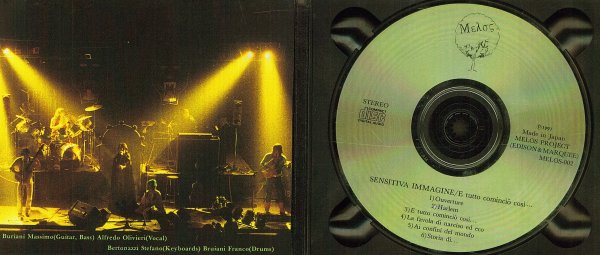
(IL) SISTEMA – Il Viaggio Senza Andata
(posthumously: 2-LP 1991, CD 1992)
This album
was released on CD in the early nineties by Mellow Records, a known Italian
prog rock label specialized in releasing seventies Italian prog like
Il Giro Strano,
Biglietto Per L'Inferno and
Jumbo.
According to my information, Mellow Records also released this CD on a double
LP with additional tracks.
Il Sistema
featured guitar player
Enzo Merogno
who later appeared in
Museo Rosenbach and
Leonardo Lagario (sax, flute, piano)
who became a member of
Celeste, both
legendary Italian prog bands! Il Sistema’s music from the era between 1969 and
1971, is mainly based upon the powerful sound of the Hammond organ evoking
Gregg Rolie
(Santana) in long tracks like
Il
Pensieri Del Mattino and
Dinamica E.
Cibernitica. I’m sure you will be carried away! Together with the
omnipresent Hammond organ, we can also enjoy good work on saxophone, flute and
electric guitar and some vocals with a melancholic undertone. The only
disappointing track is
Il Pozzo. It
is too long, sounds cacophonic, a maverick on this CD with a running time over
70 minutes. The recording quality isn’t that good, but if you are up to a
decent bootleg sound, this CD is one to discover.
TRIADE - La Storia Di Sabazio (1973)
Triade
is an obscure Italian trio that made only one
album. Their music is keyboard driven prog rock with strong hints to classical
music and
ELP (organ and
synthesizers). The combination of bombastic keyboards and acoustic guitar
sounds very pleasant. The pieces featuring strings and rhythm-guitar are
breathtaking. The running time is just over half an hour, but here you can say:
quality above quantity!
(THE) TRIP – Atlantide (1972)
Recently, I
watched an Italian TV documentary about the classic Italian prog rock with
great footage from
Banco,
PFM and
Le Orme.
I saw
The Trip
during a performance on the Caracalla Pop Festival when the band played the
single
Fantasia in front of a very
enthusiastic audience. The Trip released four albums in the first half of the
seventies:
The Trip (1970) and
Caronte
(1971) contain a kind of ‘progressive
blues-rock’ with a lot of harder-edged guitar and powerful organ, their last
Time Of Change (1973) is jazzy oriented
together with the
ELP/classical
sound that dominates all albums. I prefer their third album
Atlantide on which The Trip plays as a
trio without a guitar player. The eight songs sound pleasant and varied with
decent English vocals and strong work on keyboards: from swinging and sparkling
grand piano to bombastic Hammond and church-organ evoking
The Nice and early
ELP and some synthesizer work.
(
L’) UOVO DI COLOMBO – L’Uovo Di Colombo (1973)
L’Uovo Di Colombo
is a four piece including the brothers
Enzo Volpini
(keyboards, electric and acoustic guitars) and
Elio Volpini
(bass, electric guitar and lead vocals in the first track
L’Indecisione). Most of the tracks sound simply structured with a
very tasteful vintage keyboard colouring of mainly Emersonian Hammond organ,
but also string-ensemble, Moog-synthesizer and piano alongside some electric
guitar (fiery runs in
Turba and
Consiglio). The atmospheres range from
swinging rhythms with bombastic keyboards to dreamy. The most elaborate
composition is
Visione Della Morte.
It begins mellow with acoustic rhythm guitar and warm vocals, then a catchy
break with strong work on piano and Hammond and a short drum solo, followed by
slow rhythm featuring beautiful string-ensemble and in the end tender piano. If
you are a Hammond aficionado, this is an album worth to check out.
(IL) VOLO – Il Volo (1974)
Il Volo
made two albums in the mid-seventies. I prefer
their first eponymous effort above the second one entitled
Essere O Non Essere?
(1975), because the debut album sounds more
mature and varied and the Italian vocals have a more important role. The eight
varied and melodic compositions are tastefully coloured by two keyboard players
including
Gabriele Lorenzi
from
Formula Tre
often featuring string-ensemble and Fender Rhodes
electric piano, beautifully blended with moving electric guitar work and
instruments like an electric sitar or acoustic guitar.
Il Volo
is not a classic, but a fine example of Italian prog rock.
